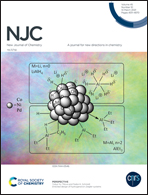Superiority of graphite coated metallic-nanoparticles over graphite coated insulating-nanoparticles for enhancing EMI shielding†
Abstract
In this work, we have used a single-step pyrolysis method in synthesizing carbonaceous materials at 800 °C and 1000 °C, using metal (Ni- or Mn-) acetylacetonate and toluene as precursors. We demonstrated that the pyrolysis synthesis temperature (TP) and the choice of organometallic precursors affect the morphology and the microstructure of the carbonaceous materials. Namely, at low temperature (800 °C), the Ni(acac)2 precursor leads to the formation of metallic-Ni catalysts for the growth of carbon nanotubes (CNTs), but at high temperature (1000 °C) this favors the growth of carbon globules (CG). In contrast, the Mn-(acac)2 precursor leads to the formation of MnO-particles, and associated carbon globules at both the temperatures used. The electromagnetic interference (EMI) shielding effectiveness (SE) of the PVDF polymer based composite specimens prepared with the carbonaceous samples having a metallic Ni-core is found to be far superior than that obtained using the specimen with particles of the MnO-core. The observed contrast in SE behavior is shown to originate due to the size and metallic nature of the Ni-nanoparticles and the Ohmic conduction loss in these metallic particles over the loss due to interfacial polarization-based scattering of the insulating MnO nanoparticles present in the PVDF-based composite films. Hence, our study highlights the necessary synthesis parameters, and the importance of graphite coated metallic nanoparticles in designing highly efficient EMI shields.



 Please wait while we load your content...
Please wait while we load your content...